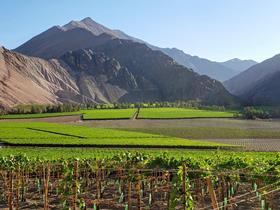
Chile expects to see a 10-15 per cent increase in table grape production in 2020/21 following the arrival of much needed rains during the winter months. This would give it an export crop of just over 85m cartons compared with 76.2m cartons last season.
“There’s a lot of fruit on the vines, so having a large number of bunches available will allow growers to make a better selection,” Christian Corssen of Frutera Santa María told Fruitnet.
The rain has brought temporary relief to a sector that has been ravaged by drought, but Corssen said it did not solve the underlying problem that some areas have with regard to water.
“A number regions still face an uncertain future as the reservoirs have not yet recovered to normal levels, so a lot depends on what happens next winter with regard to snowfall in the mountain range,” he said.
As with other producing countries, companies face higher production costs as a result of coronavirus, as well as difficulties in ensuring they have enough workers to harvest and pack this season’s crop.
While the pandemic continues to cause uncertainty in the market, Corssen said the situation is much less unpredictable than it was a year ago. “At the beginning of 2020 the onset of coronavirus caught us at the peak of the season and it was very difficult to predict how consumers would react,” he explained.
“Today we have got used to the ‘new normal’ and consumers have resumed their purchasing habits, either shopping in person or online, regardless of where each country is with regard to quarantine.”
Nevertheless, exporters will have to ensure that only firm fruit with very good quality is packed, as anything that arrives at the destination in less than perfect condition is likely to face big problems.
Meanwhile, the arrival of winter has ushered in a second wave of Covid-19 in many Northern Hemisphere countries, putting paid to hopes of a swift resolution to the crisis.
“The foodservice channel is still very diminished and in some markets such as the US this accounts for an important part of sales, together with the wholesale markets which have also suffered during the health crisis,” said Corssen.
On a more positive note, he believes the healthy eating trend should continue, which obviously favours demand for fruit and vegetables in general. “Our challenge as an industry is to strengthen the profile of grapes as a healthy product, something we have done little to promote up to now,” he says.
Chile’s varietal portfolio also continues to improve. Last season, licensed varieties made up around 22 per cent of the country’s export volume, up from 15 per cent in 2018/19, and in the current season that figure is expected to be anywhere between 30 and 35 per cent. In fact, there are now three licensed varieties among the country’s ten leading export varieties. At Frutera Santa María licensed grapes now accounting for just over half of the company’s shipment volume.
“I think the next challenge is to increase the supply of licensed seedless green varieties, since the first years of replanting have been mainly focused on red and black seedless grapes,” Corssen said.
“At the same time, we have to continue improving our knowledge of how to handle each of these new cultivars in different growing regions in order to optimise their productive and quality potential.”
Indeed, he maintains that quality is the country’s best line of defence as competition from other suppliers continues to grow. Chile’s exclusive supply windows have all but disappeared, although it is still the dominant supplier between mid-February and the end of April. And Corssen is adamant that the country’s climate, soil and water give its grapes an edge when it comes to flavour, particularly in licensed varieties.
“Today’s customers are much more demanding and I therefore believe that there are good opportunities for us in all markets as we understand what they want and are able to pack the product with the quality they expect,” he says.
The industry is working hard towards securing access to the US under a Systems Approach, thereby eliminating the need for fumigation, which would improve its competitive position in this market considerably.



